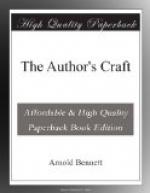The temptation of the great novelist, overflowing with creative force, is to scatter the interest. In both his major works Tolstoi found the temptation too strong for him. Anna Karenina is not one novel, but two, and suffers accordingly. As for War and Peace, the reader wanders about in it as in a forest, for days, lost, deprived of a sense of direction, and with no vestige of a sign-post; at intervals encountering mysterious faces whose identity he in vain tries to recall. On a much smaller scale Meredith committed the same error. Who could assert positively which of the sisters Fleming is the heroine of Rhoda Fleming? For nearly two hundred pages at a stretch Rhoda scarcely appears. And more than once the author seems quite to forget that the little knave Algernon is not, after all, the hero of the story.
The second rule of design—perhaps in the main merely a different view of the first—is that the interest must be maintained. It may increase, but it must never diminish. Here is that special aspect of design which we call construction, or plot. By interest I mean the interest of the story itself, and not the interest of the continual play of the author’s mind on his material. In proportion as the interest of the story is maintained, the plot is a good one. In so far as it lapses, the plot is a bad one. There is no other criterion of good construction. Readers of a certain class are apt to call good the plot of that story in which “you can’t tell what is going to happen next.” But in some of the most tedious novels ever written you can’t tell what is going to happen next—and you don’t care a fig what is going to happen next. It would be nearer the mark to say that the plot is good when “you want to make sure what will happen next”! Good plots set you anxiously guessing what will happen next.
When the reader is misled—not intentionally in order to get an effect, but clumsily through amateurishness—then the construction is bad. This calamity does not often occur in fine novels, but in really good work another calamity does occur with far too much frequency—namely, the tantalising of the reader at a critical point by a purposeless, wanton, or negligent shifting of the interest from the major to the minor theme. A sad example of this infantile trick is to be found in the thirty-first chapter of Rhoda Fleming, wherein, well knowing that the reader is tingling for the interview between Roberts and Rhoda, the author, unable to control his own capricious and monstrous fancy for Algernon, devotes some sixteen pages to the young knave’s vagaries with an illicit thousand pounds. That the sixteen pages are excessively brilliant does not a bit excuse the wilful unshapeliness of the book’s design.




